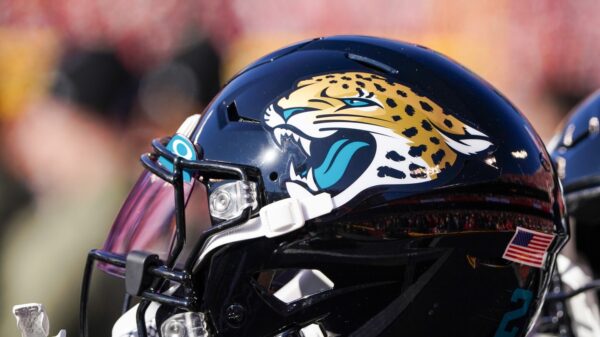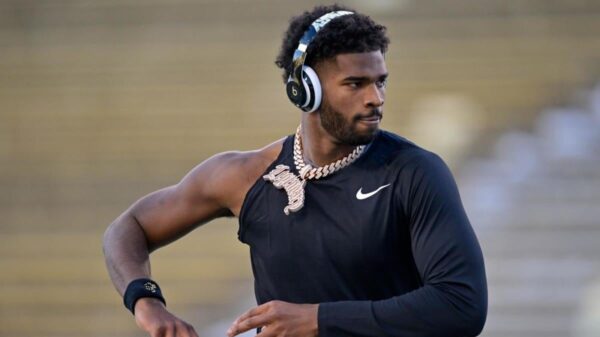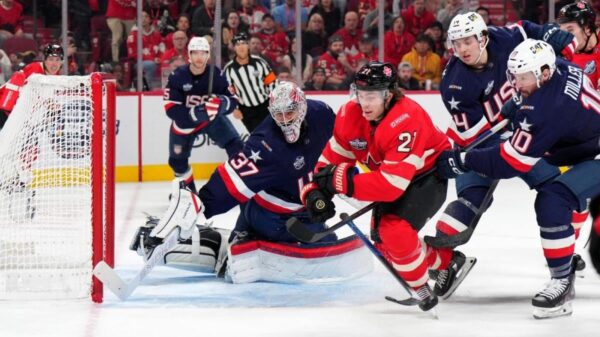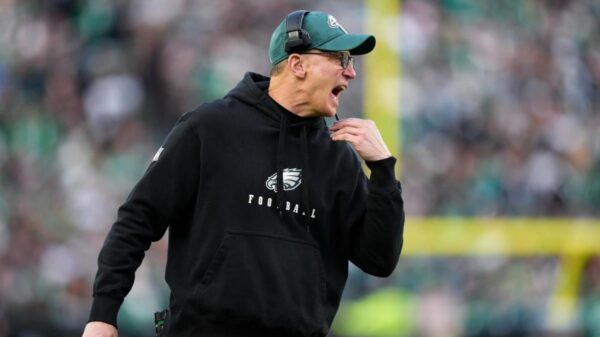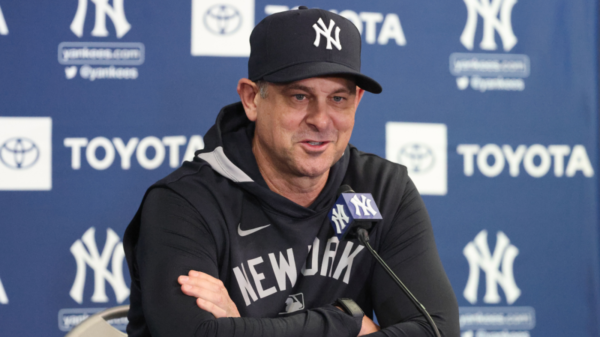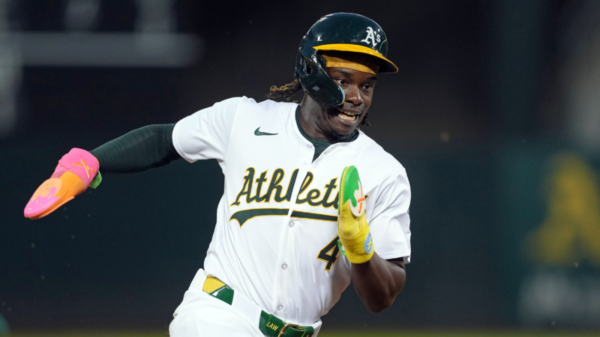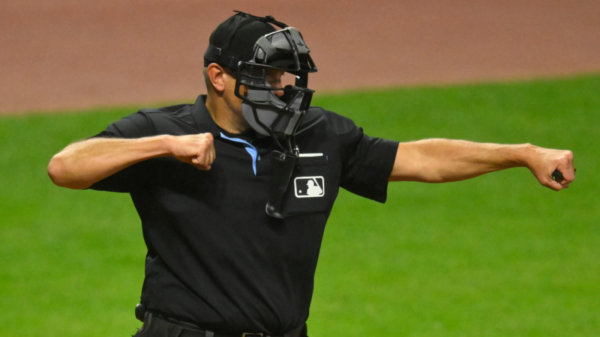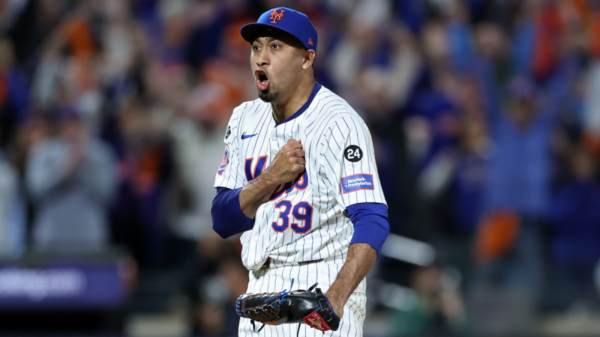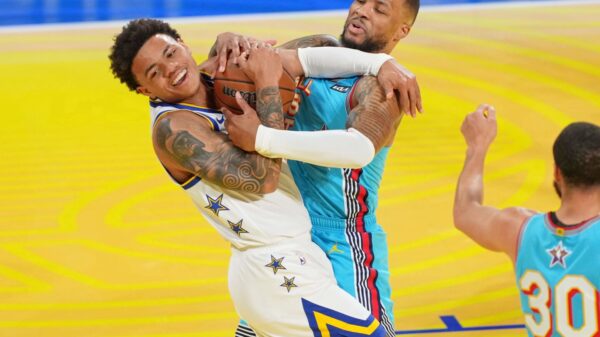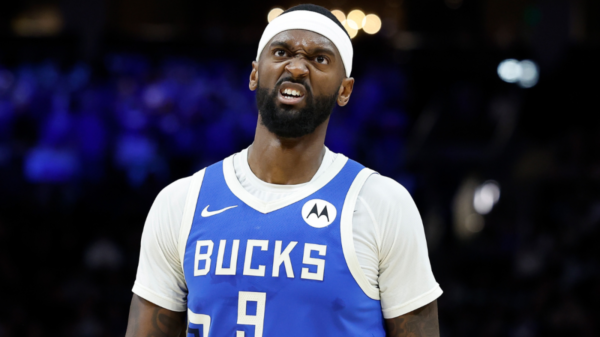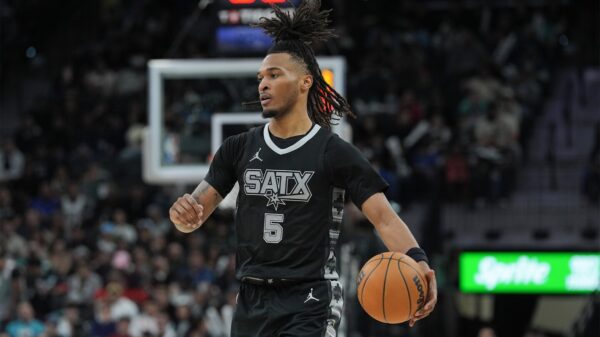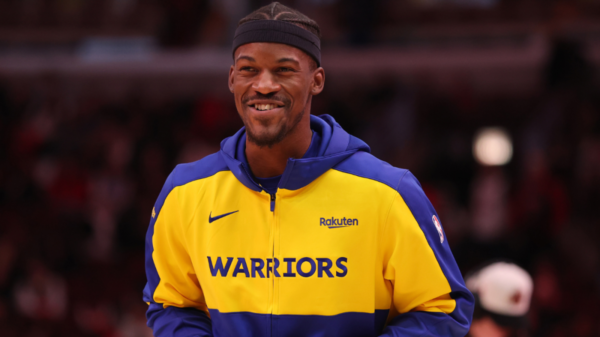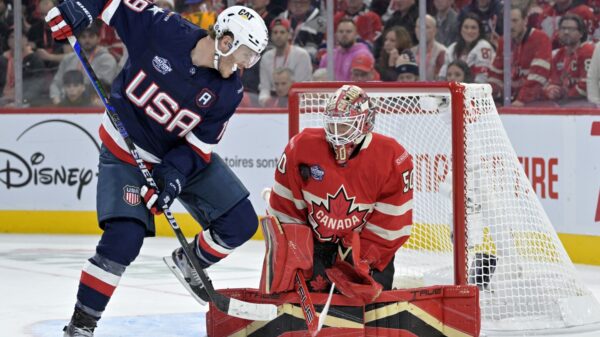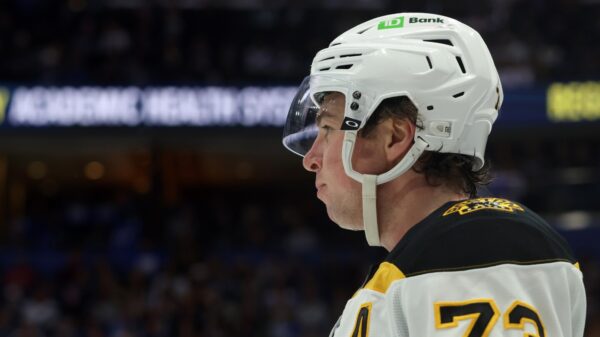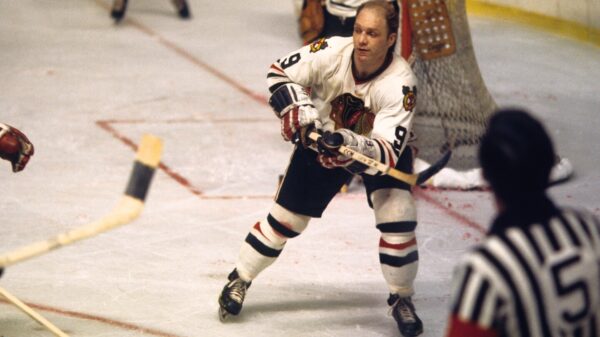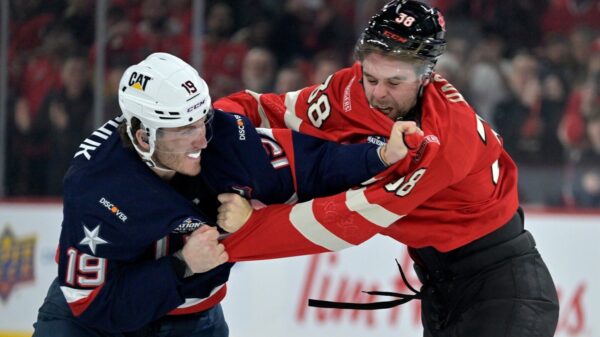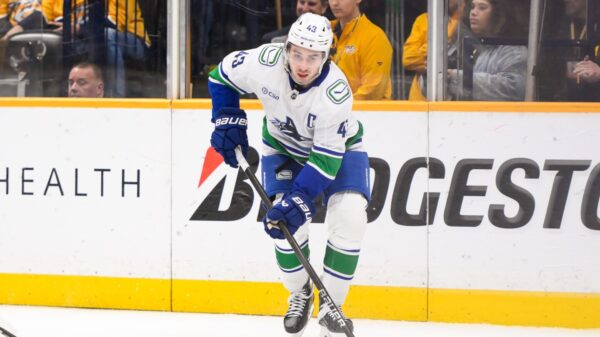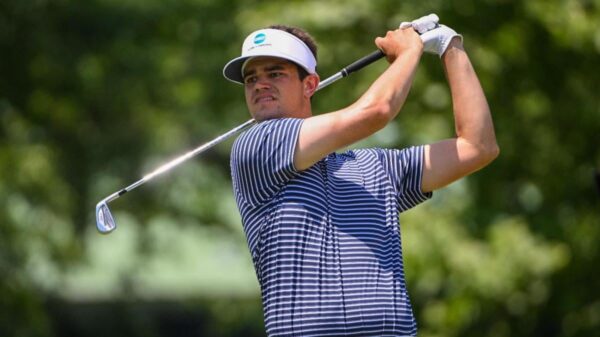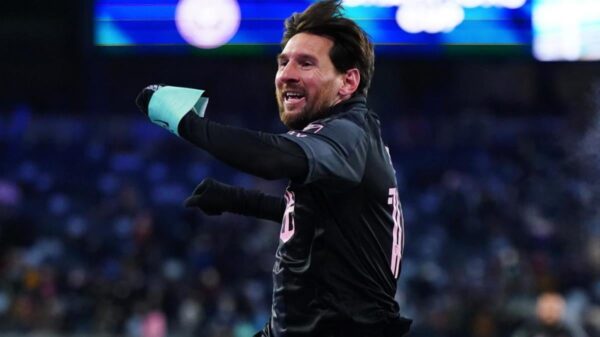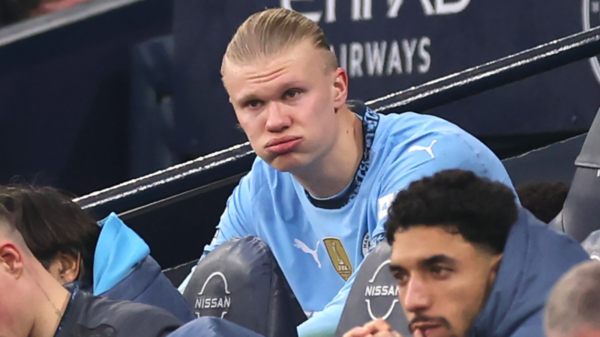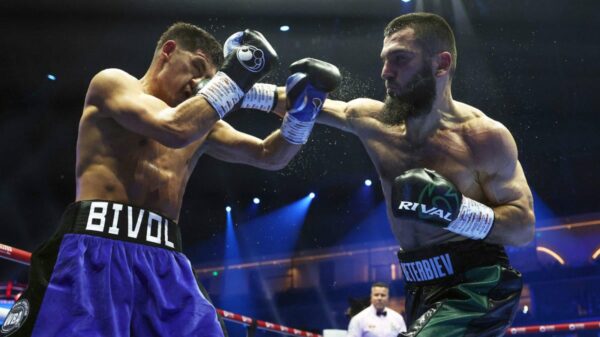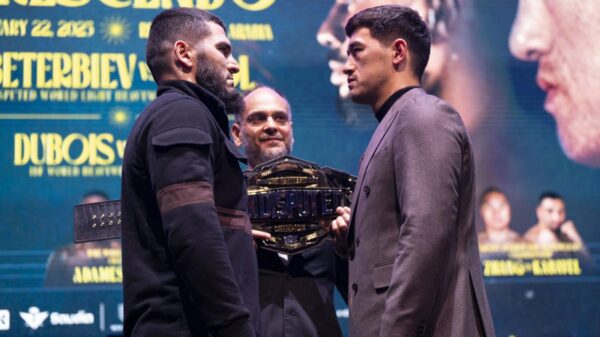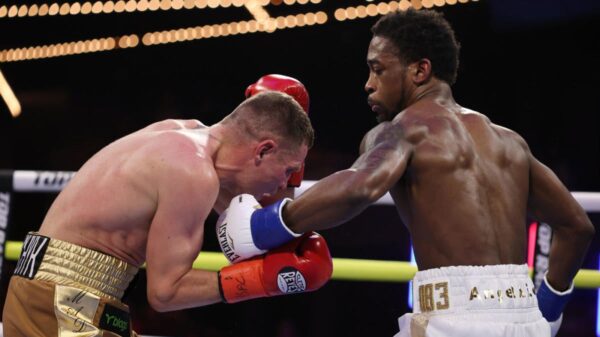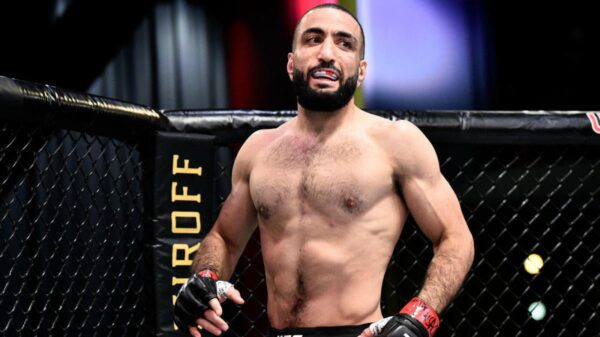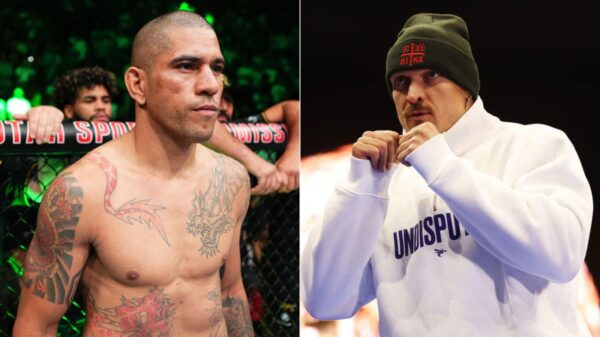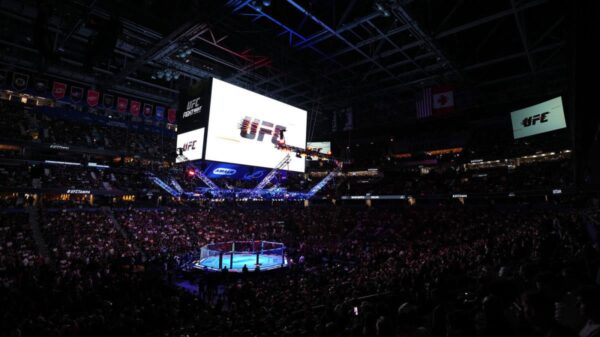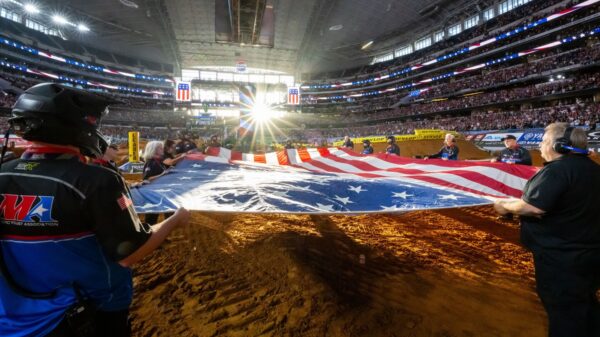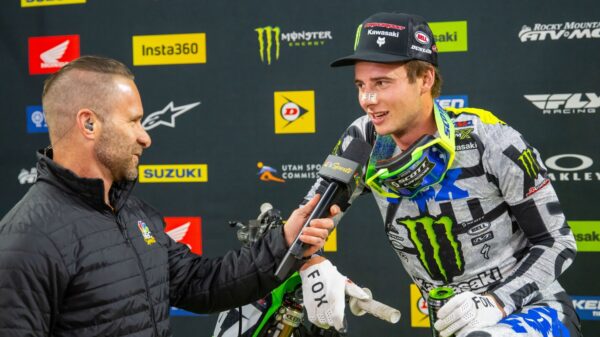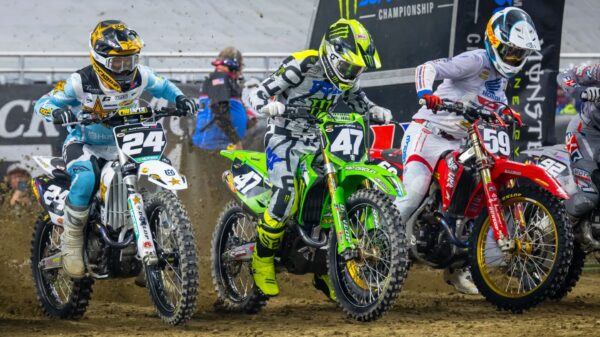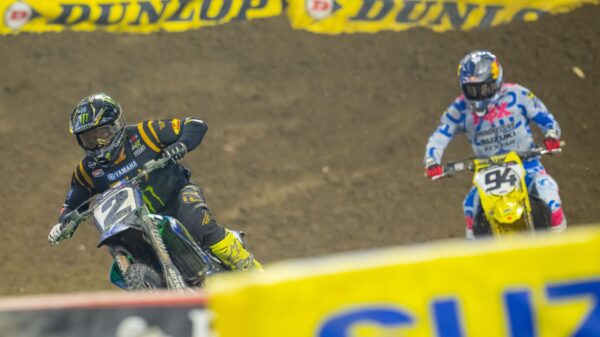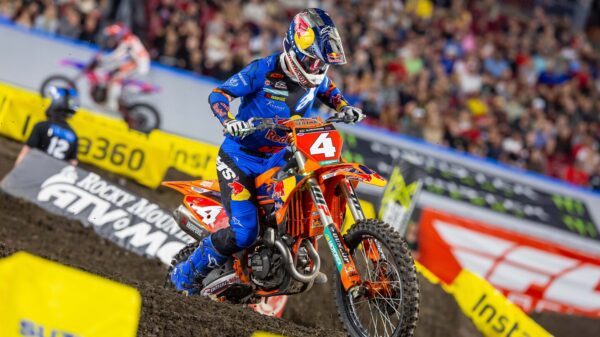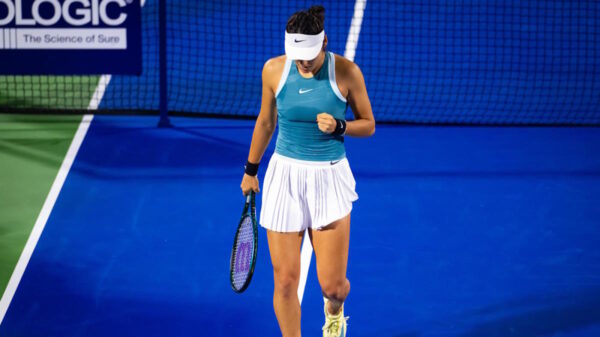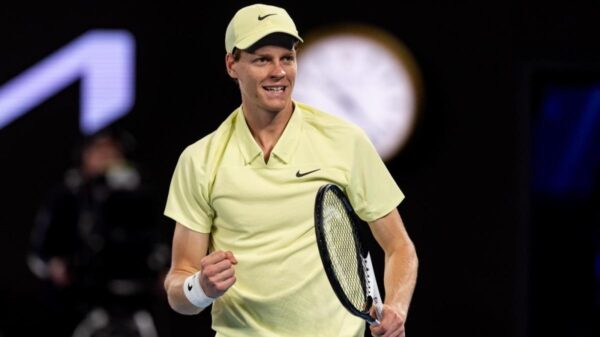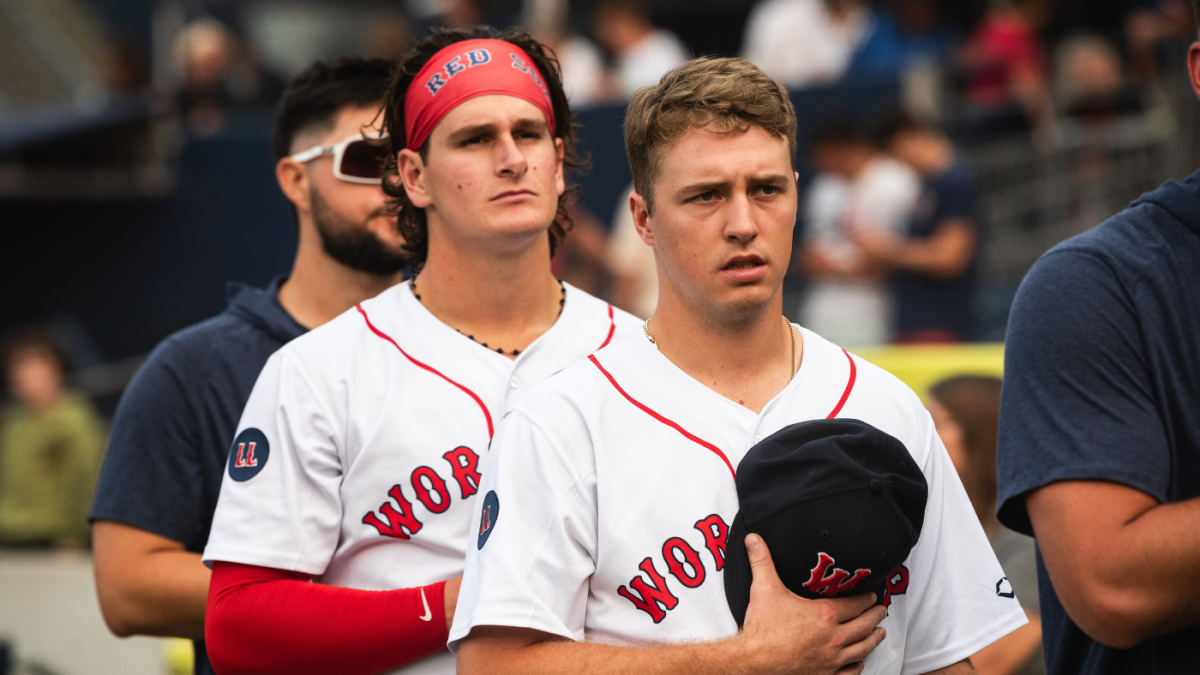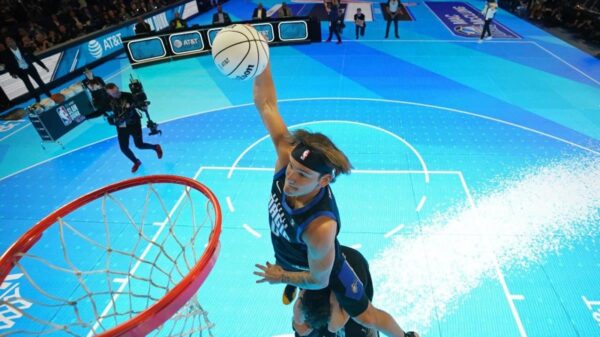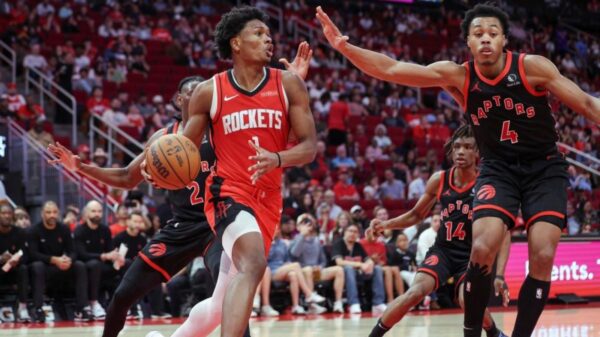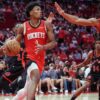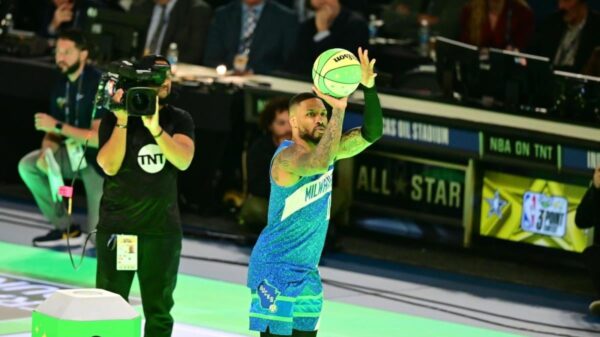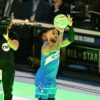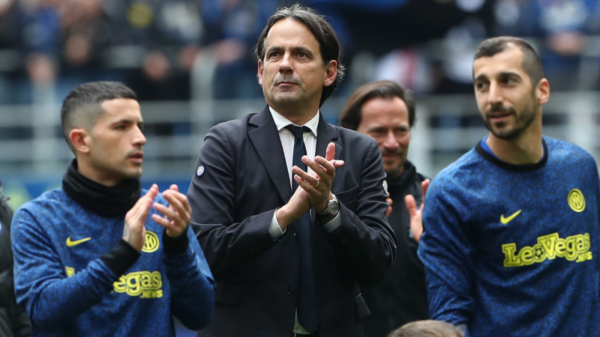Spring training games are on the horizon. We’ve spent the winter publishing our top prospect lists for all 30 individual teams. So while the players get to work dusting off their cleats and warming up their arms, it’s time for CBS Sports’ top 50 prospects list.
All of our lists are shaped by a variety of inputs. Those include conversations with scouts, analysts, and other front-office types; statistical and observational analysis; and so on. We must emphasize that we don’t care if our lists look different than other publications — variety is the spice of baseball analysis, and everyone has their own methods and predilections. (Do note that we omitted Dodgers right-handed starter Roki Sasaki because we don’t consider players with his amount of professional service time to be prospects.)
Now, let’s get to the reason you clicked.
The short hook: Accomplished young outfielder with room to grow
Anthony has a lot working in his favor. He won’t celebrate his 21st birthday until the summer, yet he’s already authored an impressive 35-game stretch in Triple-A, during which he recorded a .983 OPS and a walk for every strikeout. His advanced metrics, including his 90th percentile exit velocity and his in-zone contact percentage, line up with those posted by James Wood and Junior Caminero; his chase rate, meanwhile, was superior to both. (Wood and Caminero subsequently hit well in the majors.) If there’s an area where Anthony could obviously stand to improve, it has to be with respect to pulling the ball in the air. He has immense raw strength, the kind that could eventually result in 30-plus homers annually; it’s eyebrow-raising, then, that he pulled just 4% of his Triple-A fly balls (the MLB average last season was over 9%). This ranking is a bet on Anthony’s youth and talent allowing him to figure out that component over the coming years. Even without it, he’s a high-quality prospect nearing arrival. MLB ETA: Spring 2025
The short hook: Capable center fielder with above-average offensive potential
When it comes to prospects, familiarity can beget fatigue as efficiently as it can breed contempt. Crews, nearing his fifth consecutive year on the national radar, remains a quality prospect (several sources argued for him in the top spot) despite having not achieved instant stardom like his collegiate teammate Paul Skenes. He combines center-field athleticism with above-average offensive traits; even during his month-long cameo in the majors, he showed an aptitude for making sound contact and minding the strike zone. Crews’ swing isn’t conducive to maximizing his home-run count, but in the near term his output at the plate could resemble something along the lines of Randy Arozarena (who, over the last four seasons, has averaged 21 home runs and 24 stolen bases to go with a 120 OPS+). MLB ETA: Already debuted
3. Kristian Campbell, SS/2B/CF, Red Sox
The short hook: The breakout prospect of the year
Campbell has greatly boosted his stock since being drafted in the fourth round during summer 2023. He trained his bat speed over the winter, empowering him to launch 20 home runs last year after smoking only four during his single season at Georgia Tech. Campbell’s added muscle gives him a well-rounded game: he has a good feel for contact and the zone alike; he’s an above-average runner; and the Red Sox continue to play him at shortstop, albeit while giving him looks elsewhere on the diamond, too. Campbell already has the appearance of being a draft-day steal. Expect him to continue to enhance that perception in 2025, likely while spending a lot of time in the majors. MLB ETA: Spring 2025
The short hook: Polished hitter beyond his years
Jenkins injured himself in the first game of the regular season, causing him to miss more than a month of action. Said absence didn’t prevent him from progressing all the way to Double-A in what served as his age-19 and first full professional season. Jenkins can really hit, as demonstrated by the fact he batted .282/.394/.439 with more walks than strikeouts in 82 games spread across four levels. Provided Jenkins can tap more into his plus strength heading forward — and there’s no apparent reason that he shouldn’t — he should develop into a middle-of-the-order fixture for the Twins. MLB ETA: Summer 2026
The short hook: All-Star upside, but with some risk
Williams is a good defensive shortstop with at least 20-20 offensive potential thanks to his above-average (or better) power and speed combination. Those traits give him a high ceiling, but his ability to reach his absolute peak will be tested by a substandard hit tool. Williams has consistently struck out 28% or more of the time throughout his minor-league career, a frequency matched by only a few big-league shortstops. He has enough going for him to think he’ll be able to withstand that blemish; at the same time, he could develop into an MVP candidate if he can make more consistent contact. MLB ETA: Summer 2025
The short hook: One of the game’s better pitching prospects has to stay on the mound
Jobe made his first handful of big-league appearances late in the year, including pitching twice during the postseason. Next on the to-do list? Make his first MLB start. That ought to come sometime in 2025 thanks to a four-pitch arsenal that includes a rising mid-90s fastball, a cutter and a sweeper, and a changeup. Jobe battled his command throughout the season, but the bigger question mark here is his durability. He threw a career-high 95 innings in 2024, suggesting that he’ll need his workload managed to avoid being shut down before the regular season concludes. MLB ETA: Already debuted
The short hook: Polished lefty-hitting shortstop
Emerson had scouts swooning in the spring. He made good on that preseason hype during the year, impressing in both the California and Arizona Fall Leagues while scuffling in the Northwest League to round out his regular season. It’s hard to get too worked up about the latter experience; he was nearing the end of his first full year as a professional (a season that contained multiple trips to the injured list, mind you), and he was playing in leagues as a teenager that featured pitchers several years older. What’s important here is that Emerson projects as an above-average lefty-hitting shortstop who just needs to tap into his raw power during games. If he can do that, he’ll become a foundational piece of the Mariners’ long-term plans. MLB ETA: Summer 2026
8. Samuel Basallo, C/1B, Orioles
The short hook: Powerful lefty bat with positional questions
Basallo is a potential middle-of-the-order fixture, an imposing figure with the strength to match. That size, plus his spotty receiving and Adley Rutschman’s continued presence on the Orioles roster, has long swayed evaluators to discount his chances of remaining behind the plate. Sure enough, Basallo made more combined starts at first base and DH in 2024 than he did at catcher. It’s hard to know how much of that had to do with injuries he suffered (including a stress fracture in his throwing elbow) and how much of that had to do with the Orioles accepting his eventual relocation down the defensive spectrum as a fait accompli. Basallo’s bat is the drawing point regardless, and the reason he ranks so highly despite the uncertainty. MLB ETA: Late summer 2025
The short hook: Dynamic shortstop just needs better health
Lawlar was limited to just 23 regular-season games, all on the minor-league side, by a combination of hamstring and thumb injuries. He’ll now enter his fourth full professional season having yet to appear in more than 119 games in a single year. Lawlar nonetheless remains a compelling prospect. He offers plus defense at the six as well as above-average power and speed tools that should more than offset his swing-and-miss tendencies. If Lawlar’s body allows, he should spend most of the upcoming season serving as Arizona’s everyday shortstop. MLB ETA: Already debuted
The short hook: Talented shortstop with durability concerns
Unavailability has become the theme of Mayer’s professional career. He’s still yet to play in 100 games in a season, having missed most of the second half of 2024 on account of a lumbar strain that prevented him from making his Triple-A debut. Mayer had a good year when he was hearty and hale, nearly matching Roman Anthony’s OPS at Double-A. He’s added strength (and swing and miss) since draft night, and he continues to be an effective shortstop with more quickness than straight-line speed. That makes for a good prospect, albeit one with a spotty health track record. MLB ETA: Summer 2025
The short hook: Well-rounded center fielder
Clark has elicited comparisons to Cubs outfielder Pete Crow-Armstrong since his amateur days. We must admit that, while we dislike comps in general, there’s something to this one. Clark, like Crow-Armstrong, is a strong defender who can offer ample value on the basepaths, though neither offers a ton of in-game power at this point in their careers (Clark’s 107 mph maximum exit velocity would’ve ranked right alongside Crow-Armstrong near the bottom of the majors). The biggest difference, besides them being their own carbon-based organisms, is that Crow-Armstrong is already established on the Cubs roster and Clark is likely to start 2025 in High- or Double-A. Give it another year and some change and they’ll share something else: the majors. MLB ETA: Late summer 2026
12. Travis Bazzana, 2B, Guardians
The short hook: Last summer’s No. 1 pick can really hit
The Guardians’ love for Bazzana was a poorly kept secret within the industry, with several talent evaluators identifying him to CBS Sports as the likely No. 1 pick before the college season even got underway. Whether or not the Guardians ever wavered on their selection is for them to know, but Bazzana did his part to keep them engaged. He again showed off a well-rounded offensive game that includes excellent swing decisions and both above-average strength (despite a smaller frame) and speed. A substandard arm will limit him to second base, and it’s fair to write that he’s maxed out physically — something that divides scouts when it comes to draft prospects. Evaluators have long raved about Bazzana’s work ethic, however, suggesting he’ll be able to make any additional gains that are available to him, be they physical or otherwise. MLB ETA: Spring 2026
The short hook: Potential draft-night steal has a well-rounded game
Wetherholt slipped to the seventh pick last summer after missing half of the collegiate season because of a hamstring injury. In due time, he might reveal himself to be the best player in the class. Wetherholt has plenty working in his favor, beginning with appreciable feels for the barrel and the zone that have scouts throwing double-plus projections on his hit tool. He’s not likely to be a huge power threat, and he’s almost certain to move across the bag to second base before he reaches the majors. (Masyn Winn exists, after all.) Even so, Wetherholt has the makings of a quick-moving regular who inspires regret in at least a few of the teams that passed on him. MLB ETA: Spring 2026
The short hook: Prolonged absence hasn’t diminished upside
Painter returned to the mound during the Arizona Fall League after being sidelined for the past two seasons by Tommy John surgery. He demonstrated his health, touching 99 mph while generating plenty of swinging strikes with both his curveball and slider. Painter seemed certain to make his debut in 2023. Now, the Phillies may choose to take things a little slower with him on account of his presumed workload limitations. Either way, a healthy Painter continues to profile as a top prospect. MLB ETA: Summer 2025
The short hook: The first pitcher drafted last summer is electric
Burns didn’t pitch after being selected with the No. 2 pick in last summer’s draft. He’d already thrown 100 innings on the year, or 20 more innings than his previous high. Once he does take a professional mound for the first time, he should find himself on the inside track to the majors. Burns has a well-rounded arsenal, including an explosive upper-90s fastball and two high-quality breaking balls. He has good control, having walked fewer than three batters per nine innings in college, though he could stand to improve his command. Any gains on that front ought to give him No. 2 starter upside. MLB ETA: Spring 2026
The short hook: Fastball-slider pairing should enable 2025 debut
Dollander entered the 2023 draft cycle viewed as the best pitcher in the class thanks to an arsenal led by a stellar fastball-slider combination. He was eventually surpassed (and then some) by Paul Skenes while he battled consistency woes. Since turning pro, however, he’s done well to remind folks why he was highly touted in the first place. Dollander split last season between High- and Double-A, striking out more than a third of the batters he faced (albeit with an inflated walk rate) and positioning himself to make his big-league debut sometime in 2025. It’s never easy pitching home games at Coors Field, but Dollander has at least mid-rotation upside if he can stay on track. MLB ETA: Spring 2026
The short hook: Extreme offensive game, extreme injury history
Rodriguez is a rara avis among high-quality offensive prospects. He’s so picky at the plate that he makes Juan Soto seem overeager. Such discernment has resulted in more than half of his career plate appearances ending in a walk (21.9%) or a strikeout (29.9%). When Rodriguez does put the ball in play, he displays above-average thump. He’s also a good defender. The most worrisome aspect here is how sparse he’s been in four professional seasons: just once has he played in more than 50 games, and he’s yet to clear the 100-game threshold (though he finished 2023 with 99 appearances). The error bars are so wide here, on account of Rodriguez’s odd skill set and unreliably availability, that this could end up looking like a brutal misrank in either direction. MLB ETA: Late summer 2025
18. Ethan Salas, C, Padres
The short hook: Patience is a virtue
Your mileage may vary on Salas. The twain seldom meets when it comes to extreme youth and upper-level minor-league baseball. Yet Salas, who won’t celebrate his 19th birthday until June, has already recorded 120 games at the High-A level. That combination makes it tough to hold his poor offensive results against him; after all, he was more than four years the junior of his average opponent. Behind the plate, Salas is unthinkably polished. At the plate? Well, George Harrison sang it best: “It’s gonna take time, whole lotta precious time.” We’ll give him another year, at least, before we start seriously considering moving him down lists. MLB ETA: Spring 2026
19. Leodalis De Vries, SS, Padres
The short hook: Teenage switch-hitting shortstop with big upside
The Padres, always game to challenge their best young prospects with an aggressive assignment, tasked 17-year-old De Vries with a full season in the California League just months after signing him for more than $4 million. Although he would’ve been young for the draft, and although he was facing competition that was on average four years his senior, he produced at a level 16% above the league-average mark. (Later, in the Fall League, he hit a ball with a 110 mph exit velocity that would’ve qualified as the fastest of the season save for the likes of J.T. Realmuto, Rhys Hoskins, and Mookie Betts.) That kind of age-relative performance bodes extremely well for De Vries’ long-term outlook, and makes it easy to justify giving him a bullish ranking despite his youth. MLB ETA: Spring 2027
20. Sebastian Walcott, SS, Rangers
The short hook: Immense risk, immense reward
One of the most encouraging things a hitting prospect can do is perform well when they’re significantly younger than their competition. Walcott did just that, more than holding his own as an 18-year-old in High-A, where he routinely faced pitchers who were four years his senior. Walcott has the size and innate explosive attributes necessary to develop into a middle-of-the-order force. Given the circumstances, consider it reassuring that he struck out just 25.5% of the time — particularly since hit tool concerns were one of the biggest question marks facing his game. Another? Whether or not he’ll outgrow the shortstop position, necessitating a move to third base. For now, Walcott’s bat seems promising enough to render the matter moot. MLB ETA: Spring 2027
21. Jasson Domínguez, OF, Yankees
The short hook: The Martian is ready to make contact
Domínguez is, without rival, the most famous person on this list. He’s been nationally relevant since first signing with the Yankees as a 16-year-old and, as a reward, receiving the burden of unreasonable comparisons. The ensuing years have lowered the volume on the hype machine, but that doesn’t mean he’s a bust. Rather, Domínguez projects as a starting-caliber outfielder who can provide power and speed — particularly when there’s a right-handed pitcher on the bump. Though he switch-hits, he’s always performed better from the left side; it’s where he has a finer command of the strike zone and the barrel alike. Domínguez’s plate discipline and explosiveness should enable him to record his first full big-league season in 2025. MLB ETA: Already debuted
The short hook: Will hit wherever he plays
Rushing has primarily served as a backstop during his professional career, making it notable that the Dodgers shifted him to left field on a nearly exclusive basis after promoting him to Triple-A. (Los Angeles, you may have heard, has a good catcher in place for the next nine years.) Rushing is the rare catching prospect with the bat to play far down the defensive spectrum. He’s an on-base machine who seldom expands his strike zone to chase bad pitches. He has more than enough juice to keep pitchers honest, too, having averaged a 90 mph exit velocity during his time in Triple-A. Rushing even had a minimal platoon split, posting an almost identical OPS against lefties and righties alike. He’s all but certain to play a role in the majors in 2025. Stay tuned to find out with which team and at what position. MLB ETA: Spring 2025
The short hook: Athletic right-hander with promising arsenal
Just what the Pirates need: another talented young right-handed pitcher. Chandler was one of the overslot picks the Pirates splurged on in 2021, after they took Henry Davis at No. 1 and embraced the portfolio approach. He’s an excellent athlete who has continued to improve his control as a professional. Chandler’s arsenal includes a rising fastball that can touch 99 mph and two promising secondaries, in his changeup and slider. He closed out the season in Triple-A and seems certain to debut in 2025. MLB ETA: Spring 2025
24. Coby Mayo, 1B/3B, Orioles
The short hook: Corner infielder with power, patience
As sure as night gives in to day, the Orioles’ best young hitters struggle during their first big-league foray. Mayo was no exception, punching out 22 times in 46 trips to the plate. Rest assured, he’ll get ample opportunity to turn his ship around. Mayo has both great strength (he recorded a 114.9 mph batted ball in Triple-A) and a healthy commitment to taking free passes. He does swing and miss a fair amount, but more often than not he’s kept his strikeout rate in check. Mayo’s defensive home has been a long-term question mark; in part because of his own athletic limitations, and in part because the Orioles have a seemingly endless supply of budding infielders. Provided his bat ports in whole, it won’t really matter what positions he ends up staffing. MLB ETA: Already debuted
The short hook: Teenage outfielder with room to grow
De Paula, one of our breakout picks last spring, validated the selection by hitting around 30% better than the league-average mark and walking nearly as often as he struck out across two levels of play. Not bad for someone who won’t celebrate his 20th birthday until late next May. De Paula still needs to tap into his above-average strength on a more reliable basis; he homered only 10 times total last season and he hit nearly 50% ground balls during his 52-game stint in High-A. He’s shown enough promise overall to merit a high ranking with the potential to make a big leap in 2025. MLB ETA: Late summer 2026
The short hook: Promising corner bat, but which corner?
Smith ascended from a so-so first season at Florida State to being made the 14th pick in the draft thanks to a tweaked swing that allowed him to greatly reduce his strikeout rate. He’s now capable of contributing in each of the triple-slash categories, with his above-average strength in particular giving him middle-of-the-order potential. (To wit, none of his seven professional home runs were total pull jobs; they were all hit to left-center, center, or right field.) Questions remain about his long-term defensive home. Evaluators have expressed the belief he could slide from third base to a different corner in due time. The Astros, who obtained Smith in the Kyle Tucker trade, have stated they intend to crosstrain him at each corner position as a means of improving his and their optionality alike. MLB ETA: Summer 2025
The short hook: Potential middle-of-the-order force
Eldridge was one of the most intriguing talents in the 2023 draft: a two-way player with massive power from the left side. (Did we mention that he’s listed at 6-foot-7?) The Giants signaled their intent to let him develop both ways after drafting him at No. 16, but that declaration proved to be hot air. Not only has Eldridge already given up pitching, he did it without throwing a single professional pitch. Instead, the Giants placed him on the fast track as a first baseman. He batted .292/.374/.516 across four levels last year, ending the season with an eight-game cameo in Triple-A that has him knocking on the big-league door. Eldridge didn’t perform well in the upper minors (albeit in a small sample), making it fair to wonder if San Francisco’s new leadership would be wise to take a slower approach to his development. The reward — a middle-of-the-order thumper with on-base chops — is too great to risk botching. MLB ETA: Late summer 2025
The short hook: Bat-first infielder with pop
Shaw could find himself on the Opening Day roster after a 35-game stint in Triple-A that saw him produce a .929 OPS. (Later, during the Premier12 tournament, he matched Ken Griffey Jr.’s Team USA single-game record by driving in seven runs.) Shaw routinely makes hard contact, even possessing enough power to drive out more than a handful of balls the other way. That feel for the barrel helps obscure that he has an appetite for elevated fastballs that can get him into some trouble. Shaw has auditioned at several infield positions; he’s certainly probably going to end up at second or third base, with the latter serving as the current favorite given Isaac Paredes’ inclusion in the Kyle Tucker trade. MLB ETA: Spring 2025
The short hook: Left-side infielder with power, patience
Miller slipped to the late stages of the first round in the 2023 draft because of two concerns: one about his age (he was already 19) and the other about his long-term defensive home (he was expected to outgrow shortstop). The Phillies have reason to be happy with how things have played out. His first full professional season saw him continue to man the six while hitting .261/.366/.446, even reaching Double-A for a five-game cameo. Miller’s ball-tracking measures at High-A included above-average strength and zone control, albeit with some swing-and-miss issues within the zone and against breaking balls. He’s likely to begin the season in Double-A with an outside chance at debuting late in the year if he continues to produce. MLB ETA: Spring 2027
The short hook: Lefty with plus stuff
Mathews has his velocity and therefore his stock since being drafted from Stanford as a senior in 2023. His fastball now sits in the mid-90s, with a combination of release height and induced vertical break that’s comparable to Pirates rookie Jared Jones. Mathews’ arsenal features four other pitches, including two above-average secondaries (changeup and slider) that generated at least 50% whiffs over the nine-game sample of ball-tracking available to us. Mathews has experienced some spells of wildness dating back to college. Provided he mostly keeps his control in check, he profiles as an above-average starter. MLB ETA: Early summer 2025
The short hook: Low-slot lefty with mid-rotation upside
When it comes to pitchers, the White Sox have a type. More than anyone else, it seems, they love left-handers with lower arm slots. Chris Sale is the most obvious example, but Schultz could become the most relevant over the coming years. He’s a physical specimen (listed at 6-foot-9 and 220 pounds) with a nasty slider that has empowered him to average 12 strikeouts per nine for his career. Yet evaluators we spoke to flagged his fastball’s performance against right-handed batters. Schultz’s potential platoon problems have been on display to a lesser extent in the minors (career .413 OPS versus lefties as opposed to .603 against righties), and the belief is that big-league hitters will fare even better. Should time bear out that assertion, Schultz will likely settle in as a mid-rotation starter. Of course, it’s possible that he makes some necessary adjustments, rendering those fears moot. MLB ETA: Late summer 2025
The short hook: Walking and bopping left-handed catcher
Originally a third-round in 2022 from Missouri State University, Baldwin now finds himself on the cusp of his big-league debut. He split the season between Double- and Triple-A, hitting .276/.370/.423 with 16 home runs. Baldwin has legitimate thump, recording a handful of balls with exit velocities over 110 mph, including a 111.9 mph entry that would have placed him in the top 90 maximum exit velocities in the majors. That kind of power from a lefty-hitting catcher makes him notable on its own, but that’s not all he brings to the table. He also minds the zone well and grades as an average defender behind the dish. Atlanta’s decision to part with Travis d’Arnaud clears a pathway for Baldwin to enjoy a prolonged big-league stay in the bigs this season, with a chance for him to take the most-days job as his own if Sean Murphy again struggles. MLB ETA: Spring 2025
The short hook: Quality backstop coming off missed year
Quero (his first name is pronounced “YEFF-err-sun”) tore his labrum diving back on a pickoff attempt last Opening Day, necessitating season-ending shoulder surgery that put a bow on his year after a single plate appearance. Provided he makes a full recovery, he ought to return to being one of the better catching prospects in the game. Quero combines above-average strength (he launched 16 home runs in 90 Double-A games in 2023) with a strong defensive foundation that includes a well-above-average arm. If he can pick up where he left off (and there are no assurances of that), he should make his big-league debut before the year is out. MLB ETA: Late summer 2025
The short hook: Well-rounded catcher with swing and miss concerns
Teel, the 14th pick in the 2023 draft, was obtained from the Red Sox in the Garrett Crochet trade. He’s an athletic backstop with the potential for average or better tools in the areas that count for catchers. Teel even has above-average raw strength from the left side, though his power is likely to manifest in doubles and not home runs barring a swing change. There are some risk factors worth pointing out here, including the generally high attrition rate for backstops and some swing-and-miss tendencies that may cause his bat to play lighter at the game’s highest level. Nevertheless, he’s certain to debut sooner than later. MLB ETA: Spring 2025
The short hook: SEC-tested corner bat coming off shockingly bad debut
Condon was considered the best player in last year’s draft class: an SEC-vetted corner bat with an appealing combination of contact, on-base, and power traits who elicited comparisons to Kris Bryant, among others. It qualified as a surprise, then, that his initial exposure to pro ball saw him hit just .180/.248/.270 with 30 more strikeouts than walks in 25 High-A games. The question here is how much should you weigh that initial pro look? There’s no one right answer. It’s more than fair to write that Condon will obviously have to do much better — and quickly — if he doesn’t want the Rockies to begin regretting what appeared to be a safe pick. MLB ETA: Summer 2026
The short hook: Upside, with a capital U
The switch-hitting Made won’t celebrate his 18th birthday until May 8, and he hasn’t taken a single cut outside of the complex league. Please understand, then, that there’s a wide margin for error on this ranking. At the same time, it’s hard to ignore Made’s combination of youth; results (he hit .331/.458/.554 with more walks than strikeouts); and physical traits. He has the kind of explosiveness that bodes well for him growing into at least plus power, as well as good athleticism that enabled him to swipe 28 bases on 32 tries. Again, there’s a lot that can go wrong here. If things go mostly right, though, we’re talking about a potential star-caliber performer. MLB ETA: Spring 2029
The short hook: Low-slot lefty with mid-rotation upside
As mentioned above, the White Sox adore low-slot lefties. It wasn’t too surprising, then, when they drafted one in the first round in 2024, taking Smith at No. 5 from Arkansas. He pairs a high-quality fastball-slider combination with extreme deception borne from his release point (he has a low arm slot and he stands on the far first-base side of the rubber). The two major drawbacks for Smith are that he battled his command throughout his collegiate career, issuing free passes to more than 10% of the batters he faced last season, and that he lacks a good third pitch. There’s mid-rotation promise here, and perhaps more than that if the White Sox can help him shore up his weaknesses. MLB ETA: Late summer 2025
The short hook: Mid-rotation starter waiting on the call
The Mets liked Sproat so much that they drafted him twice: first in 2022, then again in 2023. He’s en route to validating their obsession, having compiled a 3.40 ERA and a 3.12 strikeout-to-walk ratio in his professional debut. Sproat delivers a full arsenal using a whippy arm action. His mid-90s fastball has a dead zone shape that makes it likely to play below its speed. Luckily, Sproat atones for that by deploying several above-average secondaries, including a very good changeup and sweeper. He scuffled during his initial run at Triple-A, but there’s every reason to believe he’ll right the ship and reach Citi Field sometime this summer. MLB ETA: Summer 2025
The short hook: Potential middle-of-the-order bat
Kurtz displayed resilience during his platform year at Wake Forest, overcoming a slow start and a shoulder injury en route to being selected No. 4 overall in 2024. He pairs well-above-average power with a patient approach that saw him draw a free pass nearly as often as Barry Bonds did in 2002. On paper, that gives him a strong offensive foundation that lends itself to middle-of-the-order projections. Some scouts expressed concern that Kurtz was too willing to take pitches, a counterintuitive flaw that could work against him as a professional. The recent history of first-round collegiate first basemen is wretched (CJ Cron, picked back in 2011, qualifies as the biggest success), but your mileage may vary on holding that against Kurtz. MLB ETA: Late summer 2025
The short hook: Same old, same old
Hence has a starter’s arsenal, complete with a rising fastball and two good secondaries, but it’s anyone’s guess if he’ll be able to shoulder a starter’s workload at the big-league level. The Cardinals have approached his development using the crockpot method. As a result, he’s logged just 236 regular season innings over four years, including 79 frames over his 20 starts in 2024, and he’s yet to clear the century mark in a single season. While the workload demands for starting pitchers have diminished over the past decade, it’s fair to describe this as a more extreme situation than even what the Dodgers faced with Bobby Miller a few years back. It’s only natural to wonder if Hence will end up in the bullpen or some kind of hybrid role; for now, the Cardinals have no reason to rush that call. Hence figures to spend most of his age-22 season at Triple-A with an outside chance at making his debut late in the year. MLB ETA: Late summer 2025
The short hook: Polarizing shortstop with elite contact skills
Wilson has divided evaluators since his amateur days thanks to an extreme and unusual offensive profile. His game contains just one plus tool, with that being the most important of them all: the hit tool. Wilson is a good bet to run a contact rate around 90% and a strikeout rate around 10% (to date he’s punched out in just 8% of his professional plate appearances). The issue is, well, everything else. He doesn’t have the best command over the strike zone, and he features bottom-of-the-barrel power (in part because of an unsynced kinetic chain). That combination, plus his bat-to-ball skills, mean that a good portion of his balls in play are weakly struck grounders. Wilson’s boosters see him as something like Luis Arraez if he were a competent shortstop defender; his skeptics, conversely, think of him as being more akin to, say, Fancy Cat Kevin Newman. Wherever Wilson falls on that spectrum, he’s guaranteed to be interesting. MLB ETA: Already debuted
The short hook: Singles-and-walks hitter with a chance to stick at short
McGonigle, the 37th pick in the 2023 draft, is a left-handed hitter with a great feel for contact and the zone alike. To wit, he’s compiled 26 more walks than strikeouts since turning professional as a teenager. The outstanding question on McGonigle’s offensive game is his power. He’s cleared the fences just six times in 95 games to date. He did launch a ball more than 110 mph last May, but season-ending surgery on his hamate — a wrist bone that can impact future strength — lends itself to some concerns. Even if McGonigle’s in-game slugging capacity is limited, his overall on-base skills and chances of sticking at one of the up-the-middle positions makes him worth watching. MLB ETA: Spring 2027
The short hook: Potential middle-of-the-order fixture
Montes is a massive left-handed hitter, listed at 6-foot-3 with room to fill out, who won’t celebrate his 21st birthday until October. That’s notable since he split last season between Low- and High-A, outperforming the league-average marks by 25% or or more against competition that was several years his senior. Montes’ calling card is his well-above-average strength. He’s already shown the ability to exit the ballpark to left- and right-center, and there’s every reason to believe he’ll feature pole-to-pole power by the time he’s fully developed. Montes did see his strikeout rate leap by 10 percentage points after his promotion to High-A. It’s reasonable to think that he’s always going to have a swing-and-miss component to his game, and combining that with his willingness to work counts will make him prone to punchouts. The Mariners won’t say boo provided he makes good on his promise of launching 30-plus homers a season. MLB ETA: Late summer 2026
44. Cole Young, SS/2B, Mariners
The short hook: Future leadoff hitter in the making
Young is another polished left-handed hitter, albeit one who produced at an above-average clip during his season in Double-A. He relies heavily on singles and walks, and his in-game power seems likely to be contained in the form of doubles to the gap (though he did lift a few balls out the other way). Young has also stolen 20 or more bases two years in a row, giving him a chance to provide more value on the basepaths. He’s all but certain to remain up the middle, with his eventual landing spot hinging in part on Emerson’s arrival. MLB ETA: Late summer 2025
The short hook: Optimized mid-rotation starter
Lowder was viewed as a near-finished product when the Reds drafted him sixth overall out of Wake Forest in 2023. Predictably, he reached the majors to close out his first full professional season, compiling a 1.17 ERA (albeit without the peripherals to match) in six starts down the stretch. Lowder has a four-pitch arsenal: two low-90s fastballs, a changeup, and a slider that did the best job of his offerings of evading bats. He figures to break camp as a member of Cincinnati’s rotation. MLB ETA: Already debuted
The short hook: Bat-first utility player
Keaschall, the 49th pick in 2023, reached Double-A in his first full professional season. He did so while providing above-average offense thanks to his barrel and zone awareness. Overall he notched 15 home runs and 23 stolen bases across 102 games, with most of his power coming to his pull side. Keaschall should continue to be an asset on offense. Defensively, his exact landing spot is unclear. He required Tommy John surgery that ended his season prematurely, and even before that operation the Twins were experimenting with him in center field. Wherever Keaschall ends up playing, his best position is likely to be in the batter’s box. MLB ETA: Late summer 2025
The short hook: Promising southpaw with mid-rotation aspirations
Drafting prep pitchers in the first round is risky business. The Marlins, at least to date, have no reason to regret choosing White at No. 35 in 2023. He’s a physical southpaw with a promising three-pitch mix, including a mid-90s fastball and a breaking ball that generated nearly 42% whiffs across 13 High-A starts. White has battled his command at times because of an arm stroke that sees his back elbow creep to his shoulder line; that, in turn, makes it tougher for him to get his arm in position at foot strike. Even so, White has continued to progress toward becoming at least a middle-of-the-rotation starter. For long as that remains true, don’t expect the Marlins to ask for a mulligan. MLB ETA: Late summer 2027
The short hook: Big stuff, walk rates
Misiorowski is a fascinating prospect. He’s averaged nearly 13 strikeouts per nine innings as a professional thanks to an outstanding arsenal (one pitch-quality model graded all five of his pitches as above-average) and a deceptive low-slot release. Unfortunately, his ascent has been slowed by a pesky little flaw: his well-below-average command. Misiorowski has handed out nearly six free passes per nine, calling into question his chances of lasting as a big-league starter. If the Brewers can help him tighten his handle, he has impact-starter upside; of course, if it were that simple, it would already be done. As such, Misiorowski seems more likely to land in a high-leverage relief role. We’ll give him another year to avoid that designation. MLB ETA: Summer 2025
The short hook: Up-the-middle athlete with injury, priority questions
Williams was limited to 33 regular season games last year because of wrist surgery. When he was available, he batted .215/.358/.298 across three levels while continuing to showcase a mismatched skill set. Williams has always had more strength than his 5-foot-6 frame suggests, but he’s routinely posted ground-ball rates that would put him in company with the likes of Yordan Alvarez, Brent Rooker, and other sluggers with more quantifiable power. (His max exit velocity was 107.5 mph, or Jeff McNeil territory.) As a result, Williams hits a lot of harmless fly balls that suppress his batting average (.252 career) and hamper his output. His eagerness to walk and his above-average athleticism (he seems more likely than not to end up in center field) give him value. It is fair to wonder if he would benefit from reducing his attack angle and leveraging his wheels instead of trying to milk as much slugging as possible. MLB ETA: Summer 2026
The short hook: Bat-first backstop
Ramirez, obtained from the Yankees in the Jazz Chisholm Jr. trade, is a dark horse Rookie of the Year Award candidate if the Marlins give him enough playing time at the highest level. He batted .246/.345/.411 with 22 extra-base hits across 68 Triple-A games, all the while recording an exit velocity of at least 95 mph on more than 40% of his batted balls. (The average for MLB catchers was 38.2%.) Ramirez also has a good feel for the zone and contact, making him a potential offensive force. Unfortunately, his defensive skills continue to lag, to the extent that his value could be diminished by a justifiable move down the defensive spectrum. The Marlins have every reason in the world to keep him in the squat for at least a while longer. Any meaningful gains on that side of the ball will make him into a very interesting player. MLB ETA: Spring 2025
Read the full article here

